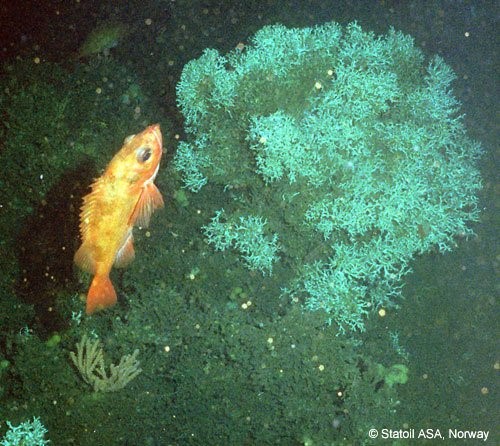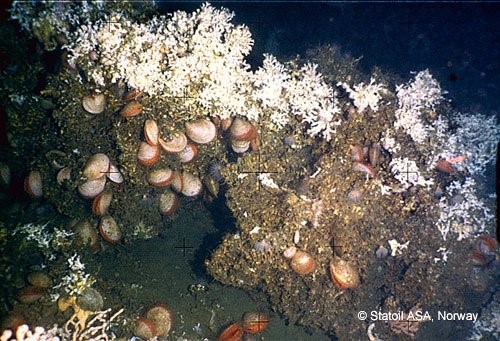Corals in the Norwegian Sea and around Draugen

Tropical reefs are found in shallow seas with clear water and good light conditions – perfect for observation by diving or snorkelling.
The banks found off Norway grow in colder seas with plenty of current in 100-500 metres of water. They can also be colourful and beautiful, and serve as centres of diversity for marine species.
However, they are far harder to observe. Photographing or filming them usually requires special equipment mounted on a remotely operated vehicle (ROV).
As a result, it is only in recent years that knowledge of these coldwater coral communities has become more detailed.
Coral reefs are built up from calcareous “skeletons” formed by tiny polyps living in colonies. Photosynthesising algae which live inside the polyp cells need sunlight to function, which is why most corals are found in clear shallow water.
Reefs will not form off the mouths of big rivers such as the Amazon, for example, because of all the particles carried in their water from erosion of the hinterland.[REMOVE]Fotnote: Store norske leksikon, https://snl.no/korallrev.
Coral reefs off Norway are built by the coldwater coral Lophelia pertusa. This grow along most of the Norwegian coast, apart from its southern end, Sogn og Fjordane county and the northernmost part of Finnmark county.
Currents and environmental factors are the most likely reasons for the absence of reefs along these sections of the coast. The flow of Atlantic water is particularly important for growth.
Since Norway’s corals account for 30 per cent of the global total of L pertusa, its seas are regarded as a core area for this species. All coral reefs off Norway are now covered by a general conservation order which prohibits any harm to them.
When it became known in the 1990s that some of these communities had been damaged by bottom trawling, such fishing was banned in the most vulnerable zones from the winter of 1992.[REMOVE]Fotnote: Store norske leksikon, https://snl.no/korallrev.
A number of new reefs have been identified in recent years, and the Norwegian Institute of Marine Research found in 2015 that they needed special protection.[REMOVE]Fotnote: Jan Helge Fosså, Tina Kutti, Pål Buhl Mortensen and Hein Rune Skjoldal (2015): Vurdering av norske korallrev. Report from the Norwegian Institute of Marine Research no 8. This has since been introduced by the Ministry of Fisheries.
Coral reefs off mid-Norway
The seas off mid-Norway contain the largest number and greatest density of reefs. Some large coral banks discovered there are estimated to be around 7 000 years old.
Some reefs grow along the outer margin of the continental shelf, while others are found on the shelf itself and in the fjords.
The Sula Ridge is special in that countless small reefs have coalesced into continuous structures of unique size. This area contains the world’s largest coldwater coral bank in deep seas.
Located in 280-300 metres of water, this reef is 13 kilometres long, up to 35 metres high and 700 metres wide. The complex grows on long ridges raised high above the surrounding seabed.
A reef complex comprises hundreds or thousands of corals which are so closely packed that they have combined into great continuous units.
Currents in the areas of reef growth can vary and flow from various directions, which provides good growth conditions on all sides.
None of the reefs are entirely similar in shape or size, and vary from tear-shaped to long banks. More or less circular reefs stand apart, with living colonies atop a zone of crushed coral on the surrounding seabed.
Generally speaking, reefs flourish on sites a little higher than the general sea bottom – on ridges, for example, the edges of fishing banks, atop iceberg ploughmarks or on fjord thresholds. L pertusa also thrives along steep cliffs in the fjords.
 Redfish and cusk caught in 300 metres of water from the Heidrun platform. Photo: Asgeir Alvestad
Redfish and cusk caught in 300 metres of water from the Heidrun platform. Photo: Asgeir AlvestadThe deepwater reefs are home to a great variety of other species, and appear to be a preferred habitat for such fish as redfish and cusk. Blackmouth catshark and rabbit fish can also be found more often over reefs than elsewhere on the seabed.
Furthermore, corals are important in the carbon cycle and thereby play a significant role for fauna and the ecosystem over a wider area than their actual physical extent.[REMOVE]Fotnote: Jan Helge Fosså, Tina Kutti, Pål Buhl Mortensen and Hein Rune Skjoldal (2015): Vurdering av norske korallrev. Report from the Norwegian Institute of Marine Research no 8.
Halten Bank and Draugen
One of the most distinctive L pertusa reefs lies a couple of kilometres east of the Draugen field. It was found in 1994 when Statoil was mapping the Haltenpipe gas pipeline route.
This exciting discovery prompted the Institute of Marine Research to conduct detailed mapping in collaboration with the Geological Survey of Norway using multibeam echosounding.
That in turn has prompted the rerouting of pipelines and the relocation of anchors for floating units.[REMOVE]Fotnote: http://www.geo365.no/olje-og-gass/tralfisket-har-odelagt-korallrev/ Haltenpipe was rerouted past the Husmus reservoir, part of the Draugen area.
Lying a few kilometres from the field, these “Haltenpipe reefs” are typical examples of a coral complex. Standing five to 30 metres high, they measure up to 50 metres across.
 A redfish browsing on an L pertusa colony in the “Haltenpipe reef”. Photo: Statoil ASA, Norway (2005)
A redfish browsing on an L pertusa colony in the “Haltenpipe reef”. Photo: Statoil ASA, Norway (2005)A Shell study of threatened marine fauna on Draugen in the autumn of 2011 indicated that some coral structures exist in the area around Draugen, close to existing pipelines and the G-3 well.
Det Norske Veritas analysed acquired videos and photographs in 2012, and concluded that there were no red-listed sponge species or habitat types. But red-listed corals were observed in places.
No good topographical maps of the seabed exist in the Husmus area, where the Draugen water injection well sits, other than some data acquired in connection with Haltenpipe. These show a few scattered reefs.
Limited visual inspections of the area by the Institute of Marine Research found indications of reefs about a kilometre directly south of well A57. This is also the counter-current outlet for the umbilical and production flowline.[REMOVE]Fotnote: http://docplayer.no/9567021-Shellexploration-production.html
The seabed along the Haltenpipe route comprises soft clay and its topography is flat in a water depth of 290 metres. Numerous depressions measuring 100 metres wide and 10 deep are found there.
A few kilometres north of the pipeline, the terrain changes to a seascape characterised by ridges and the water depth reduces to 280 metres.
L pertusa reefs close to Husmus are found on the tops and sides of some of these strange ridges. Only two of the reefs have been documented visually.
Seismic surveys suggest that deposits of frozen methane (hydrate) are found beneath the seabed around the ridges, which melt as they rise to the ridge tops.
The corals also grow in locations where this process is under way.[REMOVE]Fotnote: Hovland. http://home.hisf.no/steinbo/Marine%20geohazards/Chapters4and5DWCRHovland.pdf
But it remains to early to say whether the phenomenon has any special significance for the marine biology of the area.
Shell has issued its own coral guideline in accordance with the Oslo-Paris convention for the protection of the marine environment of the north-east Atlantic (Ospar). This is used in planning new activities in areas where corals are found.
 Numerous Acesta excavata molluscs among L pertusa corals on the “Haltenpipe reef”. Photo: Statoil ASA, Norway (2005)
Numerous Acesta excavata molluscs among L pertusa corals on the “Haltenpipe reef”. Photo: Statoil ASA, Norway (2005) Colonies of Paragorgia arborea and L pertusa amidst crushed coral on the Haltenpipe reef. Photo: Statoil ASA, Norway (2005)
Colonies of Paragorgia arborea and L pertusa amidst crushed coral on the Haltenpipe reef. Photo: Statoil ASA, Norway (2005)
